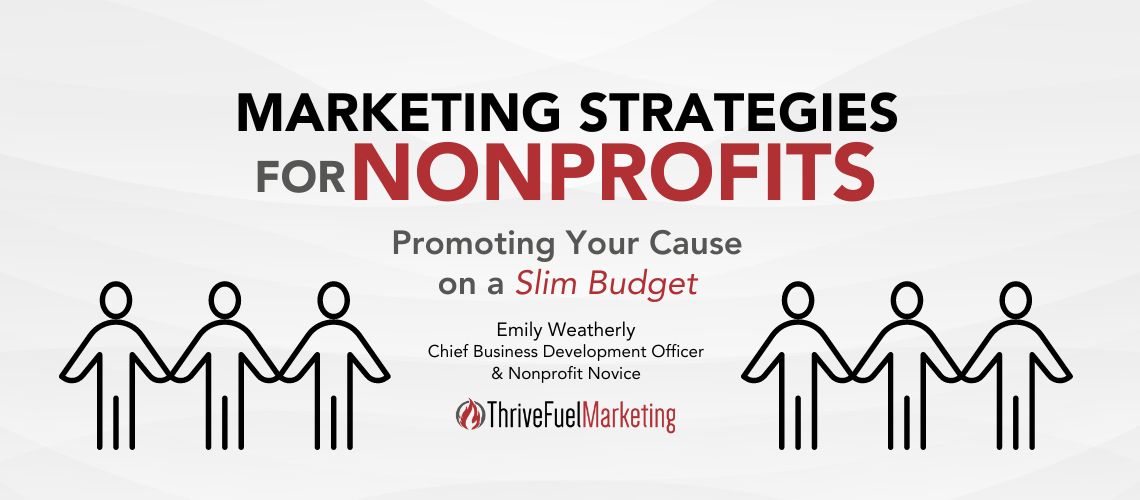In the world of nonprofits, where every dollar counts toward making an impact, marketing often takes a backseat. However, effective marketing and public relations is crucial for raising general awareness, attracting volunteers, and securing one-time, as well as ongoing funding to support your nonprofit.
Fortunately, promoting your nonprofit on a slim budget is not only possible, but it can also yield results once you have the right marketing and communication strategies in place.
1. Define Your Unique Selling Proposition (USP)
Before diving into marketing tactics (designing a flyer in Canva, writing social media post copy, etc), it’s essential to articulate what sets your nonprofit apart. What is the specific problem (or opportunity) that your organization addresses? This very specific differentiation from the other nonprofits will guide your marketing efforts and resonate with potential supporters. To thyself be true – who are you as a nonprofit and what are you doing that is different when compared to the others?
2. Leverage Social Media
Social media platforms offer powerful, cost-effective ways to reach and engage your target audience. Depending on your defined USP and work you have done to identify your target audience, then establish a presence on platforms like Facebook, Instagram, Twitter, and LinkedIn. Once the accounts are in place and optimized, now it’s time to write out your content plan. Your goal is to consistently share compelling content such as success stories, volunteer highlights, and impactful statistics. Encourage followers to share your posts to expand your reach organically. Keep in mind with changing algorithms that typically a small fraction of your organic audience will see your content. SO, it’s important to allocate some of those precious marketing dollars to extend your reach via paid social media ads.
3. Optimize Your Website
Your website serves as a digital home for your nonprofit. Ensure it is user-friendly (specifically when viewing from a mobile device), visually appealing, and optimized for search engines (SEO). Include a clear call-to-action using bright buttons on the site to prompt visitors to donate, volunteer, or learn more about your cause. Consider creating a blog to share in-depth stories or consider adding “Latest News” to post updates on events, call for volunteers and your latest press releases. If your nonprofit is active on social media platforms like Facebook, consider integrating a feed of your latest posts on your homepage so information is constantly updating on the website and not having to be done manually.
4. Email Marketing
Email remains one of the most effective tools for nurturing relationships with donors and supporters. Build an email list by collecting contact information through your website and events. Facebook forms are also a wonderful way to collect emails and provide an opt in system. Send targeted, personalized messages when possible, utilizing fields to insert first and last names or specific contact details. Share updates, success stories, and upcoming events to keep supporters engaged and informed about your nonprofit’s impact. AND, just like you do on social media, include a standard call-to-action reminding your email readers to share the email with their friends and family.
5. Collaborate with Local Influencers and Partners/Supporters
Identify individuals, organizations, or businesses that share a common interest or a similar audience with your nonprofit. Reach out to them for collaborations, such as co-hosting events, cross-promoting content on social media or backlinks on their websites, or featuring each other in newsletters. Leveraging existing networks can significantly expand your reach without requiring a substantial financial investment. With the continued explosion of video content, film short testimonials of your board members, volunteers, etc to post to social media (and your website if possible). Having their first-hand stories of why they choose to give their time and resources to your nonprofit not only has a unique storytelling angle, but also increases the likelihood of social sharing.
6. Host Virtual Events
In-person events can be costly, but virtual events offer a budget-friendly alternative. Host webinars, online fundraisers, or virtual volunteer opportunities to engage your community regardless of geographical limitations. Platforms like Zoom or Facebook Live provide accessible and interactive options for connecting with supporters and sharing your organization’s message. More and more, we are seeing nonprofits opt out of the BIG fundraisers that have been fundraising staples and opting for virtual opportunities, such as online silent and live auctions. With many virtual auction vendors available, this strategy saves precious time and resources and higher ROI for nonprofits in their fundraising efforts.
7. Harness the Power of Storytelling – Press Releases are Just the Beginning
Compelling storytelling is a potent tool for conveying your nonprofit’s impact and inspiring action. Share stories of individuals or communities positively affected by your work, using multimedia elements like videos, photos, and testimonials. Authentic narratives create emotional connections with your audience, motivating them to support your cause and spread the word. Do you have a new service or staff member to highlight? Send the details to your local newspaper, radio station, etc. Do you have an upcoming event? Inquire about opportunities to share the details live on the air on local TV, live interviews with local radio personalities, etc. These “real time” live interviews provide a disruption to the typical programming and often capture listeners attention by hearing a new local voice.
8. Maximize Free Resources
Take advantage of free resources offered by tech companies and online platforms. Google Ad Grants provide eligible nonprofits with up to $10,000 per month in free advertising on Google Search. Yes, you read correctly. Learn more HERE.
Additionally, platforms like Canva offer free design tools for creating visually appealing graphics, and platforms like Mailchimp offer free email marketing services for small subscriber lists. While not always free, TechSoup offers significant discounts on tech to nonprofits. From graphic design software to hardware like computers or tablets, register your nonprofit with TechSoup and start accessing the benefits.
9. Empower Your Supporters as Advocates
Encourage your supporters to become ambassadors for your nonprofit. Provide them with easily shareable content, such as social media graphics or pre-written email messages, to amplify your message within their networks. Recognize and appreciate their efforts publicly to foster a sense of community and gratitude. Explore ways leaders at local companies are able to distribute information on your nonprofit to their employees … think employee newsletters, employee meetings, employee training/new hire orientation. Be a part of the conversation.
10. Measure and Iterate
Track the performance of your marketing efforts using metrics like website traffic, email open rates, and social media engagement. Track your media coverage (include a cost estimate of what the news release would have cost in terms of ad space in the local paper or air time on local TV).
Analyze which tactics are most effective in achieving your goals and allocate your resources accordingly. Continuously refine your strategies based on data and feedback to maximize your impact over time. Fine tune your messaging and tactics to deliver on the channels where they resonate most.
Marketing your nonprofit on a slim budget requires creativity, strategic thinking, and a focus on building authentic connections. By leveraging digital platforms, storytelling, partnerships, and free resources, you can effectively promote your cause and inspire support for your organization’s mission without breaking the bank. Remember, the true value of your marketing efforts lies in the positive impact they enable you to make in the lives of those you serve.
Emily Weatherly
Chief Business Development Officer
ThriveFuel Marketing



